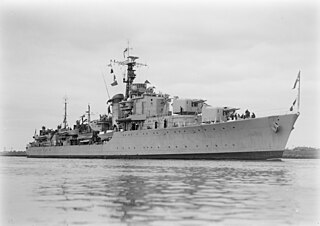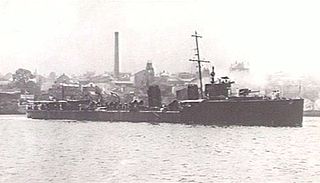Related Research Articles

Five ships of the Royal Australian Navy have been named HMAS Sydney, after Sydney, the capital city of New South Wales.
Three ships of the Royal Australian Navy have been named HMAS Canberra, for Canberra, the capital city of Australia.
One ship and one shore base of the Royal Australian Navy have been named HMAS Derwent, after the Derwent River in Tasmania.
Two ships and one shore establishment of the Royal Australian Navy (RAN) have been named HMAS Huon, after the Huon River in Tasmania.
Four ships of the Royal Australian Navy been named HMAS Parramatta, for the Parramatta River. The name comes from the Barramattagal people.
Three ships of the Royal Australian Navy (RAN) have been named HMAS Stuart:
Three ships of the Royal Australian Navy (RAN) have been named HMAS Swan, for the Swan River in Western Australia.
Two ships of the Royal Australian Navy have been named HMAS Tobruk, after the town of Tobruk in Libya and the siege fought there in 1941.
Two ships and a shore establishment of the Royal Australian Navy (RAN) have been named HMAS Torrens, after the River Torrens.
Two ships of the Royal Australian Navy (RAN) have been named HMAS Vampire.
There have been one ship and one shore establishment in the Royal Australian Navy (RAN) named HMAS Waterhen. The first ship originally served under the name HMS Waterhen with the Royal Navy (RN). A British ship and an Australian ship of the name were ordered but later cancelled.
Two ships of the Royal Australian Navy (RAN) have been named HMAS Australia. A third ship was to receive the name, but her transfer from the Royal Navy to the Royal Australian Navy was cancelled:

HMAS Anzac (D59) was a Battle-class destroyer of the Royal Australian Navy (RAN). Named after the Australian and New Zealand Army Corps, the destroyer was commissioned in 1951. The ship served on two tours of duty during the Korean War, and attempts to distinguish herself from British ships led to the practice of red kangaroo symbols on Australian warships. During 1956, Anzac served during the Malayan Emergency. In 1960, a malfunction in the destroyer's gun direction equipment caused Anzac to fire directly on sister ship HMAS Tobruk during a gunnery exercise, with Tobruk left unrepairable. In 1961, the destroyer was reclassified as a training vessel. Anzac remained in service until 1974, and was sold for breaking a year later.

HMAS Brisbane was a Town class light cruiser of the Royal Australian Navy (RAN). Built in Sydney between 1913 and 1916 to the Chatham subtype design, Brisbane operated in the Indian Ocean, Pacific Ocean, and Australian coastal waters during World War I.

HMAS Melbourne was an Adelaide-class guided-missile frigate of the Royal Australian Navy, which entered service in 1992. Melbourne has been deployed to the Persian Gulf on several occasions, and served as part of the INTERFET peacekeeping taskforce in 2000. On 26 October 2019, Melbourne was decommissioned from the RAN, subsequently being transferred to Chile. The ship was commissioned into the Chilean Navy as Almirante Latorre on 15 April 2020.
Three ships of the Royal Australian Navy have been named HMAS Wollongong, after the city of Wollongong, New South Wales
Two ships of the Royal Australian Navy have been named HMAS Warrnambool, for the city of Warrnambool, Victoria.

HMAS Huon (D50), named after the Huon River, was a River-class torpedo-boat destroyer of the Royal Australian Navy (RAN). Originally to be named after the River Derwent, the ship was renamed before her 1914 launch because of a naming conflict with a Royal Navy vessel.
Two ships of the Royal Australian Navy (RAN) have been named HMAS Success.
Brisbane is the capital city of Queensland, Australia.
References
- ↑ "Navy Marks 109th Birthday With Historic Changes To Battle Honours". Royal Australian Navy. 1 March 2010. Archived from the original on 13 June 2011. Retrieved 23 December 2012.
- ↑ "Royal Australian Navy Ship/Unit Battle Honours" (PDF). Royal Australian Navy. 1 March 2010. Archived from the original (PDF) on 14 June 2011. Retrieved 23 December 2012.